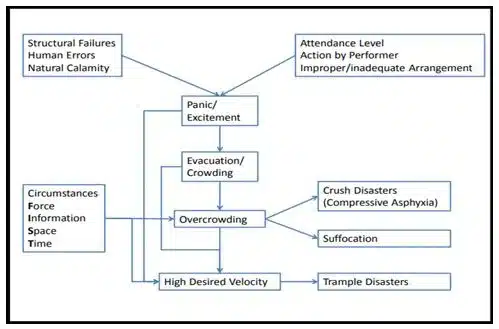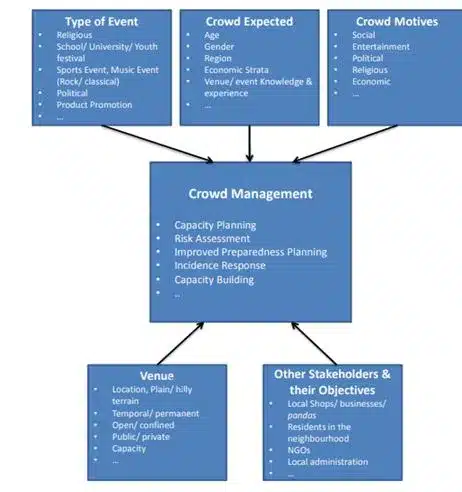- Crowd Disaster Management refers to the substantiated and systematic planning and the guidance given to the orderly progress of occurrences where large crowds of people gather in a common area. As an element of crowd management, steps can be taken to control or restrict the conduct of groups of people.
- Stampede
- The term stampede is applied to a sudden rush of a crowd of people, usually resulting in many injuries and death from suffocation and trampling. Stampedes are caused by surge of individuals in a crowd, in response to a perceived danger, loss of physical space or excitement.
- Even when crowd disasters are not a recent phenomenon, they were supposed to be of localized nature and hence were not given their expected prominence. Nevertheless, with the ever-rising Indian population, large groups gathering at locations such as religious destinations, shopping malls, railway stations etc., might result in a mishap. Therefore, creating a national policy to manage this crowd disaster has become imperative.
Causes of Crowd Disaster
- Structural failures: The destruction of the interim facility, vertical stairs, narrow building because of unlawful structures, hawkers and parking, etc.
- Electric/Fire Disasters: Generally from the makeshift kitchens in public places, improper use of firecrackers or incorrect electrical wiring during the occasion.
- Crowd Behavior: Minimizing the size of the mass, lack of coordination with management, overselling of the tickets, mass panicking by sudden rush or rumours to get celebrity autographs or freebies.
- Inadequate Security: Insufficient deployment of safety team or security agencies taking drastic actions like firing teargas leading to in-crowd panic.
- Lack of coordination among administrative agencies: Lack of coordination between administrative agencies like fire service, police, shrine management, etc.

National Guide on Crowd Management-NDMA
In view of the recurring stampedes at places of mass gathering, including religious places, and typically ad-hoc responses to those, the National Disaster Management Authority (NDMA) had prepared ‘Suggestive Framework for Preparation of Crowd Management Plan for Events/Venues of Mass Gathering’.

The major recommendations include:
- Understanding venue, visitors and stakeholders:
- The basic element for event planning and crowd management is understanding the venue, visitors and different stakeholders.
- It requires understanding of Type of event (such as religious, schools/ university, sports event, music event, political event, product promotion etc.); Expected Crowd (age, gender, economic strata), Crowd Motives (such as social, academic, religious, entertainment, economic etc.); Venue (location, topography of area, temporal or permanent, open or closed), and role of other stake holders (such as NGOs, neighbours of event venue, local administrators etc.)
- Crowd Handling
- Traffic around the mass gathering venues should be properly regulated.
- There should be a route map for venues along with emergency exits route maps.
- There shouldBarricade facility to control the movement of crowd queues.
- Snake line approach should be followed in case large crowd queues
- The organizers of crowded events/venue managers should discourage general admissions and have plans to handle VIP visitors or, alternatively, refuse entry to VIPs where it adds to safety concerns.
- Safety and Security:
- The venue Organisers should ensure authorised use of electricity, fire safety extinguishers and other arrangements as per the safety guidelines.
- It suggests use of CCTV cameras to monitor crowds and use of mini UAV incase crowd spread is too big
- Communication: A public address system, with loudspeakers installed at all crowded points, to communicate with the crowds.
- Medical and Emergency care: Medical first-aid rooms and emergency operations centres to handle post-disaster emergencies should be set up.
- Role of Event Managers: The event organizers and venue managers should develop, implement, review and revise the disaster management plan in coordination with others including local administration and police.
- Role of Civil society: Event/venue managers can involve NGOs and civil defence in traffic control, people flow control, medical assistance, sanitation and mobilization of local resources in case of disaster.
- Role of police: The police should actively participate in venue assessment and preparedness checks and guide crowd and traffic movements.
- Capacity Building: Capacity building, conducting drills, periodic assessment of training of security personnel, police is essential to prevent crowd disasters
